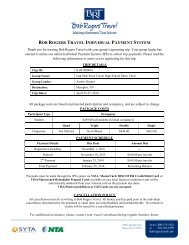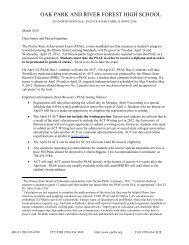X - Oak Park and River Forest High School
X - Oak Park and River Forest High School
X - Oak Park and River Forest High School
You also want an ePaper? Increase the reach of your titles
YUMPU automatically turns print PDFs into web optimized ePapers that Google loves.
<strong>Oak</strong> <strong>Park</strong> <strong>River</strong> <strong>Forest</strong> <strong>High</strong> <strong>School</strong>201 N. Scoville<strong>Oak</strong> <strong>Park</strong>, IL 60302Strategic Plan Steering Committee MinutesJanuary 7, 2013Dr. Isoye opened the Strategic Plan Steering Committee meeting at 7:02 p.m., January 7, 2013 in the StaffCafé of the OPRFHS, 201 N. Scoville, <strong>Oak</strong> <strong>Park</strong>, Illinois.Members:Nina Allen, Thrive Counseling CenterDr. Allan Alson, FacilitatorJan Arnold, <strong>Park</strong> District of <strong>Oak</strong> <strong>Park</strong>Marge Balchunas, OPRFHSRebecca Teasdale, <strong>Oak</strong> <strong>Park</strong> Public LibraryMary Jo Burns, Ascension <strong>School</strong>Leah Carlin, OPRFHSDick Chappell, <strong>River</strong> <strong>Forest</strong> Community CenterAleta Clardy, Community MemberAnthony Clark, Community MemberR<strong>and</strong>all Clark, Community MemberRobert Cole, Village of <strong>Oak</strong> <strong>Park</strong>Dr. Edward Condon, <strong>River</strong> <strong>Forest</strong> Elementary<strong>School</strong>sJP Coughlin, OPRFHSJohn Duffy, Community MemberValerie Fisher, OPRFHSJoyce Gajda, OPRFHSKathryn Gargiulo, OPRFHSNancy Guarino, Community MemberDr. Tina Halliman, OPRFHSSheila Hardin, OPRFHSNancy Heezen, OPRFHSBurcy Hines, APPLEMaria Hoye, Community MemberJames Paul Hunter, OPRFHSDr. Steve Isoye, OPRFHSStephanie Jackson, Community MemberMary Johnson, StudentKris Johnson, OPRFHSAmbria Jones, OPRFHS StudentGrace Kavinsky, StudentRay Kennelly, Dominican UniversityKathy Kern, ParenthesisLarry L<strong>and</strong>fair, Community MemberDana Limberg, OPRFHSSophia Lloyd, OPRF Community FoundationPat Maunsell, FacilitatorMelanie McQueen, ParentJohn Messina, APPLAUSEKerry Nelson, PTO/P4SSCarolyn Newberry-Schwartz, Collaboration forEarly ChildhoodSharon Patchak-Layman, OPRFHSRegina Peterson, OPRF Scholarship Foundation.Phil Prale, OPRFHSJanice Pyrce, Citizens' CouncilBobbie Raymond, Alumni AssociationBrian Reilly, OPRFHSLatroy Robinson, StudentNathaniel Rouse, OPRFHSAnna Schaider, Roosevelt PTOJoanne Schochat, District 97Steve Schwartz, OPRFHSCarollina Song, Gwendolyn Brooks PTOJohn Stelzer, OPRFHSJessica Stovall, OPRFHSKarin Sullivan, OPRFHSDrew Swope, StudentRick Tanksley, <strong>Oak</strong> <strong>Park</strong> Police DepartmentJane Townsley, ParentMark Trinka, HephzibahJason Tyszko, Community MemberAlysia Wallace, OPRFHSBrenda Jones Watkins, Triton CollegeKimberly Werner, Supported Education AssociationCathy Yen, BOOSTERSMembers not present: Maria Hoye, Nancy Guarino, Burcy Hines, Stephanie Jackson, Larry L<strong>and</strong>fair, JanicePryce, Jason Tyszko, Anthony Clark, <strong>and</strong> Ronald Clark, community members; Jan Arnold, <strong>Park</strong> District of<strong>Oak</strong> <strong>Park</strong>; Bobbie Raymond of Alumni Association; Wyanetta Johnson of APPLE; James Paul Hunter, DanaLindberg, OPRFHS faculty members; Steve Isoye, Superintendent; Alysia Wallace, Marge Balchunas, JohnStelzer, Brian Reilly, OPRFHS Staff; Jan Pryce of Citizens Council; Dr. Edward Condon of District 90;1
Brenda Jones Watkins of Triton College, Latroy Robinson, Grace Kavinsky, Drew Swope, Mary Johnson,students, Mark Trinka of Hephzibah; Robert Cole of the Village of <strong>Oak</strong> <strong>Park</strong>; Chief Rick Tanksley of the <strong>Oak</strong><strong>Park</strong> Police Department <strong>and</strong> Cathy Yen, BOOSTERS.Visitors:Rich Mertz, OPRFHS Faculty Member, <strong>and</strong> Rebecca Bibbs <strong>and</strong> Jon Langley of the <strong>Oak</strong>Leaves.Updates of EveningFocus Groups – Data <strong>and</strong> DiscussionDr. Alson reviewed what had occurred at the December 17 meeting with regard to values. The surveydeadline was extended until January 6. The results will be shared at the Saturday, January 12 meeting.Focus Group ResultsMs. Maunsell then reviewed a PowerPoint presentation that provided an analysis of the focus group data.She shared that it had been a great process as many stakeholders participated <strong>and</strong> from them, a breadth<strong>and</strong> depth of information was learned. The Committee members were commended on their efforts tomake people aware of these opportunities, as those efforts were productive. The stakeholder groupsincluded students, faculty, administrators, staff, <strong>and</strong> the community-at-large. A breakdown of the numberof people who participated in each group <strong>and</strong> their estimated ethnic representation was provided. Note: Amajority of the staff <strong>and</strong> faculty participated in the August 2012 Institute Day Focus Groups. For eachstakeholder group, two categories of analysis were provided: 1) Strong agreement across stakeholdergroups; <strong>and</strong> 2) Mixed agreement across stakeholder groups. The analysis of the results did not reveal athird category—a strong disagreement across stakeholder groups. Ms. Maunsell reviewed the results ofeach stakeholder group, which was provided in the packet.Student FeedbackStudents were complimented for having the courage to discuss issues such as race, <strong>and</strong> what did <strong>and</strong> didnot work with regard to teaching styles <strong>and</strong> effectiveness. Several African-American students spokeabout being the only person of color in their classes <strong>and</strong> it became a personal issue for them. Theconversation did not lead to the students offering solutions to problems.Faculty FeedbackMs. Maunsell noted that there was high regard for colleagues. One of the points of interest was thatteachers felt more support was needed from administrators in terms of professional development, etc.Administrators too felt that teachers needed more support. Another item regarding communications wasthat teachers did not underst<strong>and</strong> why a program ended. Relationship building has class size implications.Administrator FeedbackAdministrators feel that while they converse about what needs to occur in the building with regard todiversity, race, special education, it does not necessarily reach the entire school community, etc. This isan issue of communication. An alignment between the policies <strong>and</strong> the procedures is needed.Staff FeedbackThe staff noted that recruiting <strong>and</strong> retaining a diverse staff was necessary. While teachers want to buildrelationship with students <strong>and</strong> other staff members, the building is losing its personal touch. Themailroom is no longer necessary as everyone now is directed to a website. Staff felt that rules neededenforcement. They, too, did not underst<strong>and</strong> why a program failed or succeeded.Community Feedback2
The community focus groups did a Strengths, Weaknesses, Opportunities, <strong>and</strong> Threats (SWOT) analysis<strong>and</strong> Ms. Maunsell noted the articulation between high school <strong>and</strong> the feeder groups <strong>and</strong> the support of thehigh school. She reviewed the slides of the presentation.Information was then shared with the committee as to what stakeholders were saying that could informthe strategic plan in the areas previously identified as emerging themes.EquityStrong agreement across stakeholder groups Expectations <strong>and</strong> achievement gaps exist <strong>and</strong> is a problemo Better underst<strong>and</strong>ing of diversity <strong>and</strong> issues within OPRFHS are neededo Address inequities <strong>and</strong> tracking systemMixed stakeholder views Trackingo Inevitable: just strengthen transition <strong>and</strong> college prep levels versus needs to change—African-American students are stuck in low tracks.o Parents’ Role• Want to support all students versus some parents know how to work the systemwhich perpetuates inequitiesHolistic Community EducationStrong agreement across stakeholder groupso Strong commitment <strong>and</strong> engagement in education across al stakeholder groupso Differences in academic <strong>and</strong> social preparation by elementary district <strong>and</strong> individualmiddle school.Mixed Stakeholder Views Focus on all students versus perception hat to support achievement for all will take somethingaway from students currently achievingTransformation Teaching, Learning, <strong>and</strong> LeadershipStrong agreement across stakeholders Inconsistency in instructional delivery, quality <strong>and</strong> expectations Support for instructional improvement (e.g. coaching, PD)Mixed Stakeholder Views Preparing all students for college? What does it mean? Consistent ExpectationsSupportive Learning EnvironmentStrong agreement across stakeholders Need for more personalization <strong>and</strong> relationship building within <strong>and</strong> across stakeholder groupsMixed stakeholder views Behavior/Discipline Drugs/Alcohol/FightingFacilities <strong>and</strong> FinanceStrong agreement across stakeholders Need for alignment of resources to support equity Must prepare for enrollment growth Technology must be upgraded <strong>and</strong> consistent throughout the schoolMixed stakeholder views Fund balance3
Threads running throughout all stakeholder groups across all categories Equity Communications Academic Expectations Need for consistent instructional leadership through OPRFHS Seamless quality of connections across institutional entitiesRather than offer solutions to their own problems, students addressed their roles as students, e.g., gettingtheir homework done, etc. Note: an editorial submitted for the student newspaper, Trapeze, specificallyaddressed some solutions in the November 16 issue.Ms. Maunsell informed the Committee that while the focus group sessions were recorded <strong>and</strong> she tookverbatim notes, anonymity within the group had been stressed. If the group wanted more examples theycould be provided, but Ms. Maunsell stated that she <strong>and</strong> Dr. Alson had worked hard to provide an analysisthat was comprehensive <strong>and</strong> reflected what was heard across the groups. A question was raised about notunderst<strong>and</strong>ing what was meant by a ―disconnect between teachers <strong>and</strong> administration‖? It was explainedthat teachers wanted administrators to be in the classroom more <strong>and</strong> to talk with them more about doingtheir jobs in order for administrations to underst<strong>and</strong> the struggles of being a good teacher. Theadministrators had wanted more information about the quality of instruction, the need for improvement,<strong>and</strong> instruction for students.Several committee members felt that the data provided was valuable <strong>and</strong> sufficient, as it reflected acommon current with all schools that have this diversity <strong>and</strong> middle class. Ms. Raymond had asked whatOPRFHS could do to take what other inspirational ideas schools in the United States with similarperceptions had taken. She wanted to take the next steps. Mr. Duffy was disturbed by the analysis, as hedid not feel the focus on professional development, inequities in the schools system, etc., was explicitlystated. He was concerned about quantitative data. He too was tired of analysis, noting that MSAN hadspent years gathering data <strong>and</strong> not enough action. Dr. Alson noted that over 100 people had volunteeredto come <strong>and</strong> speak at the focus groups <strong>and</strong> that this was the best data from those who attended. Everygroup was enthused <strong>and</strong> supportive of OPRHFS, yet they did say there was room for improvement. Inanalyzing the data, there was clear intent to capture strong agreement, mixed, <strong>and</strong> strong disagreement.However, no strong disagreement was found.Next, the Committee participated in an exercise where they were to create two grids, one for equity, <strong>and</strong>one for holistic community education. Committee members were asked to list under each of these theimplications of forming ―equity‖ <strong>and</strong> ―holistic community education‖ goals.Next StepsSaturday, January 12 DetailsThe details for the January 12 all-day meeting were as follows:1) Location – 3 rd floor library2) Time 9 a.m. to 3:00 p.m.3) Purpose – dive more deeply into equity <strong>and</strong> holistic community education.February 4 – draft statements will be reviewed around the values mission, vision, <strong>and</strong> goals,The dynamics of the task forces will be as follows: Approximately 12 people Additional staff <strong>and</strong>/or community members may participate The task forces will have the same diversity as the Steering Committee4
The task forces will meet during February, March, <strong>and</strong> April.Steering Committee members will be asked for their preference of task force.The goal will determine goals.The task forces will report to the Steering Committee May 6, at which time the SteeringCommittee members may respond.The Steering Committee will meet in March, April, <strong>and</strong> May. The Board of Education will receive a firstread of the Steering Committee’s plan at its June Committee meeting <strong>and</strong> it will be asked to approve it atits regular June Board meeting.AdjournmentThe meeting adjourned at 9:02 p.m.5
















